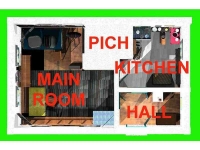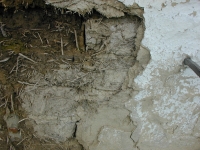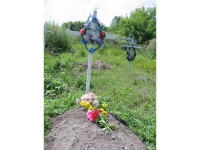The House of Baba San’ka
The home of Oksana Fedorivna Kryvorot, called Baba San’ka, village of Velykyi Khutir, Drabiv region, Cherkasy province. She was born in this village in 1918. She married a young man who lived just 150 meters away. Thus, the house in which she was born is visible from the house used for this model. Her husband, like most men of his generation, was called to serve in the Second World War and Oksana was left alone with her mother-in-law to tend to the house and its fields. When the neighbors pointed out to them that their house had started to lean, the two women rebuilt it and the house used as the model here is the one constructed by Baba San’ka and her mother-in-law. The layout of the house and the construction methods and materials are traditional. The door leads into an entryway where shoes are removed and where necessary supplies can be stored. The entryway opens up into a large kitchen and dining area. From the kitchen, there is a door to the main room or kimnata. This is where guests are received at the table under the icon corner. There are two sets of icons. One is the set with which Oksana and her husband were married and the other is the set from the wedding of the husband’s parents. Opposite the icon corner is a bed, used for visitors, and the back of the stove. Baba San’ka sleeps on the shelf of the stove. The house is wattle construction, like the Latysh House. The frame is large posts between which smaller stakes were sunk. Reeds are woven over the posts and then covered with three layers of clay. Each layer is allowed to dry before the next is applied.
Baba San’ka was a “culture keeper.” She was interested in village art and village lore. When she was younger, she would meet with other villagers, primarily women, to sing songs. These women were also the core of the pevcha, the church choir. There is an active church in Velykyi Khutir now and, until she started to ail, Baba San’ka sang regularly at church, also singing as part of baptisms, weddings, funerals and other ritual occasions. Baba San’ka was very interested in arts and crafts. She embroidered and crochetted and her house was decorated with fiber arts of her own making.
Baba San’ka died March 8, 2004 and is buried in a simple grave in the church yard.
This is a model of her house.




